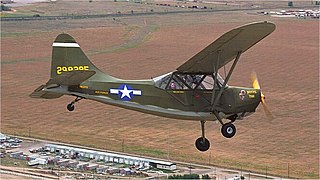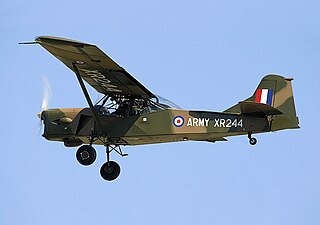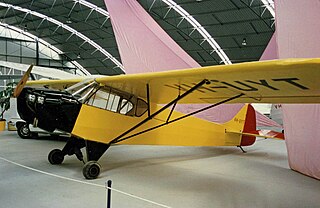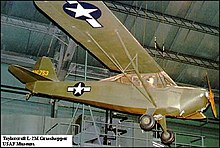
Auster Aircraft Limited was a British aircraft manufacturer from 1938 to 1961.

A liaison aircraft is a small, usually unarmed aircraft primarily used by military forces for artillery observation or transporting commanders and messages.

The Piper J-3 Cub is an American light aircraft that was built between 1938 and 1947 by Piper Aircraft. The aircraft has a simple, lightweight design which gives it good low-speed handling properties and short-field performance. The Cub is Piper Aircraft's second most-produced model after the PA-28 Cherokee series with over 20,000 built in the United States. Its simplicity, affordability and popularity invokes comparisons to the Ford Model T automobile.

The Sopwith 1+1⁄2 Strutter is a British single- or two-seat multi-role biplane aircraft of the First World War. It was the first British two-seat tractor fighter and the first British aircraft to enter service with a synchronised machine gun. It was given the name 1+1⁄2 Strutter because of the long and short cabane struts that supported the top wing. The type was operated by both British air services and was in widespread but lacklustre service with the French Aéronautique Militaire.

The Grumman FF "Fifi" is an American biplane fighter aircraft operated by the United States Navy during the 1930s. It was the first carrier aircraft with retractable landing gear. It was produced under licence in Canada and known as the Goblin in Canadian service and Delfín in Spanish service.

The Taylor Cub was originally designed by C. Gilbert Taylor as a small, light and simple utility aircraft, evolved from the Taylor Chummy. It is the forefather of the popular Piper J-3 Cub, and total production of the Cub series was 23,512 aircraft.

The Stinson L-5 Sentinel is a World War II-era liaison aircraft used by the United States Army Air Forces (USAAF), U.S. Army Ground Forces, U.S. Marine Corps and the British Royal Air Force. It was produced by the Stinson Division of the Vultee Aircraft Company. Along with the Stinson L-1 Vigilant, the L-5 was the only other USAAF liaison aircraft that was exclusively built for military use and had no civilian counterpart.

The Taylorcraft Auster was a British military liaison and observation aircraft produced by the Taylorcraft Aeroplanes (England) Limited company during the Second World War.

The Aeronca Model 7 Champion, commonly known as the "Champ", or "Airknocker", is a single-engine light airplane with a high wing, generally configured with fixed conventional landing gear and tandem seating for two occupants.

The Auster AOP.6 was a British military air observation aircraft produced by Auster Aircraft Limited to replace the numerous wartime Taylorcraft Auster aircraft then in-service.

The Auster AOP.9 was a British military air observation aircraft produced by Auster Aircraft Limited to replace the Auster AOP.6.

The Commonwealth Skyranger, first produced as the Rearwin Skyranger, was the last design of Rearwin Aircraft before the company was purchased by a new owner and renamed Commonwealth Aircraft. It was a side-by-side, two-seat, high-wing taildragger.

The Taylor J-2 Cub is an American two-seat light aircraft that was designed and built by the Taylor Aircraft Company. The company became the Piper Aircraft Company and the J-2 was first of a long line of related Piper Cub designs.
No. 665 "Air Observation Post" Squadron, RCAF was formed in England during the Second World War. It was manned principally by Royal Canadian Artillery (RCA) and Royal Canadian Air Force (RCAF) personnel, with select British artillery pilots briefly seconded to assist in squadron formation. Numbers 651 to 663 Squadrons of the RAF were air observation post units working closely with Army units in artillery spotting and liaison. A further three of these squadrons – Nos. 664, 665 and 666 – were RCAF AOP squadrons manned by Canadian and British personnel.

The Taylorcraft Model D is a light aircraft of the US manufacturer Taylorcraft Aviation from the early 1940s.
664 Squadron AAC is a squadron of the British Army's Army Air Corps. It was formerly No. 664 Squadron, a Royal Air Force air observation post squadron associated with the Canadian 1st Army during the Second World War and later part of the Royal Auxiliary Air Force. Numbers 651 to 663 Squadrons of the RAF were air observation post units working closely with British Army units in artillery spotting and liaison. A further three of these squadrons, 664–666, were manned with Canadian personnel. Their duties and squadron numbers were transferred to the Army with the formation of the Army Air Corps on 1 September 1957.
Clarence Gilbert Taylor was an early American aviation entrepreneur and co-founder of the Taylor Brothers Aircraft Corporation in Rochester, New York. He was the designer of the Taylor Cub, which led to the creation of the Piper Cub, one of the most popular airplanes in history.

The Taylor Chummy, originally the Arrowing Chummy is a light utility aircraft made by the Taylor Aircraft Company in the late 1920s. It was the fore-runner of the highly successful Piper Cub series.
The Taylorcraft 15, which entered production as the 15A Tourist was an American-built general-purpose high-wing monoplane of the 1950s. It was a four-seat development of the two-seat Taylorcraft BC, fitted with a more powerful engine.

















